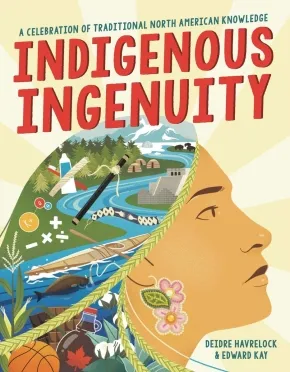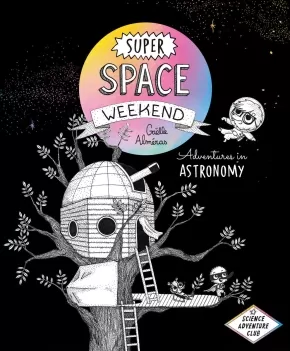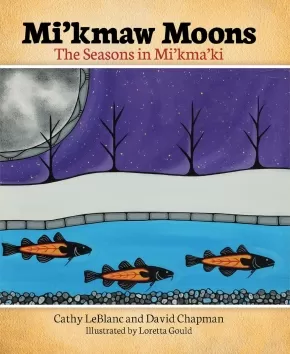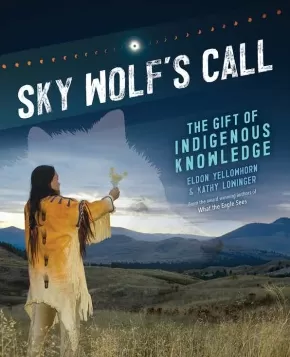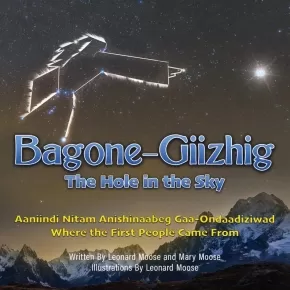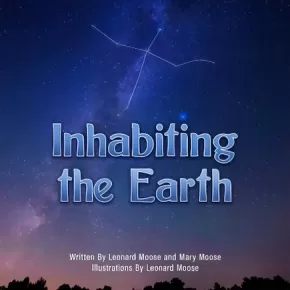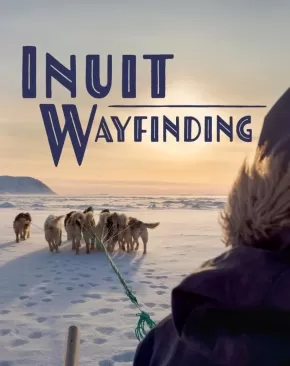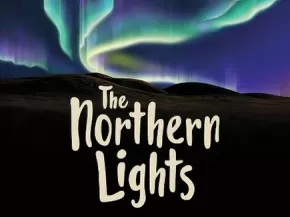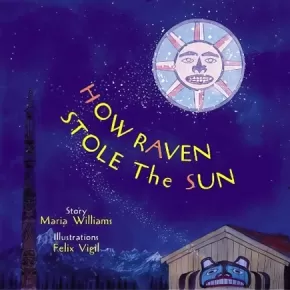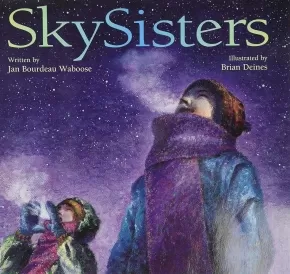
Astronomy
1
-
15
of
17 Results;
Sort By
Go To
of 2
Indigenous Ingenuity: A Celebration of Traditional North American Knowledge (PB)
$12.99
Artists:
Format:
Paperback
ISBN / Barcode: 9780316413435
Synopsis:
Synopsis:
Celebrate Indigenous thinkers and inventions with this beautifully designed, award-winning interactive nonfiction book—perfect for fans of Braiding Sweetgrass.
Corn. Chocolate. Fishing hooks. Boats that float. Insulated double-walled construction. Recorded history and folklore. Life-saving disinfectant. Forest fire management. Our lives would be unrecognizable without these, and countless other, scientific discoveries and technological inventions from Indigenous North Americans.
Spanning topics from transportation to civil engineering, hunting technologies, astronomy, brain surgery, architecture, and agriculture, Indigenous Ingenuity is a wide-ranging STEM offering that answers the call for Indigenous nonfiction by reappropriating hidden history. The book includes fun, simple activities and experiments that kids can do to better understand and enjoy the principles used by Indigenous inventors. Readers of all ages are invited to celebrate traditional North American Indigenous innovation, and to embrace the mindset of reciprocity, environmental responsibility, and the interconnectedness of all life.
Reviews
"An astonishing, exuberant treasure trove of history, science and hands-on activities that repeatedly begs the question: "Why didn't I know this?" Essential for kids and adults. We need this book." —Candace Fleming, award-winning author of The Rise and Fall of Charles Lindbergh and The Family Romanov
"This book will amaze readers and teachers as it demonstrates how pervasive and critical the history of Indigenous people is. A completely unique and important narrative not to be missed; readers and teachers will come away with a new appreciation for the myriad contributions Indigenous people have made."—SLJ, starred review
"A conversational tone invites readers to engage with this monumental collection . . . Curious readers will learn facts unique to individual tribal groups while gaining knowledge of STEM/STEAM concepts. An ambitious, appealing, and accessible work documenting and protecting valuable knowledge."—Kirkus Reviews
"Engaging and informative, this will be welcomed by both STEM and social studies curricula to help to correct prevailing narratives about Indigenous technology."—Booklist, starred review
"Via authoritative, meticulously researched prose, the creators detail Native peoples’ significant strides in scientific pursuits . . . [and] showcase Native tribes’ continual and enduring impact. Photographs, as well as interactive activities detailing recipes and science experiments, feature throughout, lending a hands-on approach to this clear and concise work."—Publishers Weekly
"This book is a valuable contribution to efforts to decolonize learning and introduce readers to the breadth of indigenous knowledge as practiced in widely disparate geographic zones."—Canadian Review of Materials
"An engaging and cleverly compiled guide to North American and Mesoamerican Indigenous innovation. STEM topics (housing, medicine, clothing, agriculture, and hunting among them) are compellingly and conversationally discussed."—Shelf Awareness
Educator Information
Recommended for ages 8 to 12.
Fountas & Pinnell Text Level Gradient: Z
Additional Information
288 pages | 6.95" x 9.00" | Paperback
Super Space Weekend: Adventures in Astronomy
$19.95
Artists:
Format:
Paperback
ISBN / Barcode: 9781778401091
Synopsis:
Synopsis:
This non-fiction graphic novel for kids 7+ takes readers on a thrilling voyage through our universe. Get ready for the ultimate astronomy adventure!
It's a beautiful evening when Squeak, Orni, and Castor head out for a weekend of camping. But Squeak has a surprise: he's hosting them all in his observatory, high at the top of a tree. The tree house is delightful—and fully equipped for the most incredible discoveries: in the sky and the stars, through the galaxy and beyond.
Readers join the three friends as they explore the night sky, our solar system, and how our universe was created. Along the way, they share fascinating facts about astronomy, such as how to find the North Star, the difference between comets and asteroids, and the history of space exploration.
Super Space Weekend features:
- Fascinating information about astronomy and space reviewed by scientists, including an astrophysicist and planetary scientist. Discover how to find the North Star, learn about the history of space exploration, and more!
- Comic-style illustrations: shares Squeak, Orni and Castor’s thrilling space adventures through a graphic novel format
Captivating, funny, and highly informative, Super Space Weekend is the ultimate introduction to the world of astronomy.
Educator & Series Information
Recommended for ages 7 to 12.
This book is part of the Science Adventure Club series.
Curriculum Connections: Space Science, Solar System, STEM.
Additional Information
96 pages | 8.00" x 9.75" | Paperback
Mi'kmaw Moons: The Seasons in Mi'kma'ki
$24.95
Artists:
Format:
Paperback
Text Content Territories:
Indigenous Canadian; First Nations; Mi'kmaq;
ISBN / Barcode: 9781459507036
Synopsis:
Synopsis:
Traditional teachings about the moon cycles and their relation to the natural history of Mi’kma’ki on Canada’s East Coast.
For thousands of years, the Mi’kmaq have been closely observing the natural world and the cycles of the moon and the stars to track the passage of time. Each full moon in an annual cycle was named by the Mi’kmaq to relate to a seasonal event, such as tomcod spawning, birds laying eggs or berry ripening.
For the past decade, Mi’kmaw Elders and Knowledge Keepers have shared stories of the traditional night sky calendar with authors Cathy LeBlanc and David Chapman. In this book, Cathy relays these stories in her role as Auntie to her young relation Holly.
Each moon’s story is richly illustrated with an evocative colour painting created for this book by the noted Mi’kmaw artist Loretta Gould.
Alongside this presentation of the Mi’kmaw time-keeping traditions, this book offers a brief history of the modern Western calendar, and some basic astronomy facts about the moon’s phases and why the seasons change.
This two-eyed seeing approach takes young readers on a journey through one full year in Mi’kma’ki.
Educator Information
Juvenile fiction.
Includes some Mi'kmaw words.
A board book version is available here: Mi’kmaw Moons: A First Lunar Calendar.
Additional Information
56 pages | 11.02" x 9.01" | Paperback
Sky Wolf's Call: The Gift of Indigenous Knowledge
$16.95
Format:
Paperback
Text Content Territories:
Indigenous Canadian; Indigenous American;
ISBN / Barcode: 9781773216294
Synopsis:
Synopsis:
From healing to astronomy to our connection to the natural world, the lessons from Indigenous knowledge inform our learning and practices today.
How do knowledge systems get passed down over generations? Through the knowledge inherited from their Elders and ancestors, Indigenous Peoples throughout North America have observed, practiced, experimented, and interacted with plants, animals, the sky, and the waters over millennia. Knowledge keepers have shared their wisdom with younger people through oral history, stories, ceremonies, and records that took many forms.
In Sky Wolf’s Call, award-winning author team of Eldon Yellowhorn and Kathy Lowinger reveal how Indigenous knowledge comes from centuries of practices, experiences, and ideas gathered by people who have a long history with the natural world. Indigenous knowledge is explored through the use of fire and water, the acquisition of food, the study of astronomy, and healing practices.
Reviews
"An authoritative tribute to Indigenous knowledge systems that's a must-have for every library and classroom." - Kirkus Reviews
“Sky Wolf’s Call has an astoundingly broad scope introducing Indigenous Traditional Ecological Knowledge (TEK) in North America from time immemorial to the current day … This fast paced celebration of Indigenous innovation and technology is riveting.” - The British Columbia Review
Educator Information
Interest Age: 11+
Grade: 6+
Reading Age: 11+
A Junior Library Guild Gold Standard Selection
Table of Contents
Author’s Note
1: Sky Wolf’s Call: The Gift of Indigenous Knowledge: Foundational ideas behind Indigenous Knowledge and the importance of retaining, maintaining, and learning this sacred knowledge.
2: Water Knowledge Ways: Water links us all and is sacred. Indigenous people have fought to protect the gift of water from harm, and the critical role it has played in transportation, agriculture, irrigation, and food.
3: Fire and Smoke Knowledge: Fire and smoke are great gifts, including the burning of tobacco. In sacred ceremonies, smoke connects our breath with the heavens. Fire cooks our food, helps grow our crops, and even keeps our waters clean. Cultural burns are used to benefit the land.
4: Indigenous Knowledge and Food Security: Sharing, growing, and receiving food with family, community, and visitors is both an honour and a tradition. By understanding the traditional practices of salmon fishing, clam gardens, planting and harvesting certain crops, or hunting buffalo, Indigenous Peoples have respected what Mother Earth has to offer.
5: Healing Knowledge Ways: The use of the medicine wheel and the sweat lodge have been used over centuries and still help sick and troubled people. Games such as lacrosse and chunkey have helped in building individual strength and community spirit. And braiding together Indigenous healing and western science has opened new learning opportunities.
6: Sky Knowledge: From the earliest Indigenous astronomers to modern astrophysicists, these sky watchers have studied the sacred gifts of the sky: the sun, moon, planets, and stars that have produced maps, calendars, beliefs about how to govern, and even directions for building homes.
7: Keeping the Knowledge: Indigenous People hold oral narratives in high esteem because that was the way knowledge passed from one generation to the next. People in North America recorded important events with symbols, pictographs (paintings), and petroglyphs (carvings). Language Keepers and Knowledge keepers are making sure that Indigenous knowledge is never forgotten.
8: Sky Wolf’s Call: Indigenous knowledge is based on the idea that this world is a gift. Understanding the idea of connections (the skies with the earth, people with animals, the practical with the spiritual) is an important lesson with the challenges of climate change, pandemics, and wars. The wisdom of Indigenous Knowledge can help the whole world.
Thanks and Acknowledgments
Glossary
Selected Reading
Sources and Contacts
Additional Information
120 pages | 7.50" x 9.25" | Paperback
Bagone Giizhig: The Hole in the Sky / Aaniindi Nitam Anishinaabeg Gaa-Ondaadiziwad / Where the First People Came From
$22.99
Artists:
Format:
Paperback
Text Content Territories:
Indigenous Canadian; First Nations; Anishinaabeg; Ojibway;
ISBN / Barcode: 9781990297151
Synopsis:
Synopsis:
"Aadizookaanan or Sacred Stories were passed down for thousands of years, filling the long winter nights with Anishinaabeg oral histories, philosophies, and ceremonies. Bagone-Giizhig is one of the many ancient stories that Anishinaabeg Ancestors have gifted us. The constellations of Wenaboozhoo and Bagone-Giizhig rise in the East during the Winter season. This signifies when it is time to share Aadizookaanan and reminds the Anishinaabeg of where they come from. These cultural Teachings shine bright in the night sky and this is the Anishinaabe way of life."
Text in English translation and in the original Anishinaabemowin/Ojibwe.
Educator Information
Recommended for grades 4 to 7.
Dual-language: English with the original hand-written Anishinaabemowin version of the story at the back.
Additional Information
61 Pages
Inhabiting the Earth
$22.99
Artists:
Format:
Paperback
Text Content Territories:
Indigenous Canadian; First Nations; Anishinaabeg;
ISBN / Barcode: 9781990297021
Synopsis:
Synopsis:
"Our Ancestors passed, Adizookaanan, our legends, down for thousands of years, filling the long winter nights with our oral history, philosophy, and ceremonies. Ajijaak is one of our many ancient stories that our Ancestors have gifted us. The many teachings of the animals, the stars, the Clan structures, and the four elements are brought to life through Ajijaak.
Many stories were passed on to Mary as a child. She shared Ajijaak with Leonard. Leonard’s love for the Anishinaabeg and concern that our way of life was being lost especially our oral traditions, decided he would work hard to bring the translation of Ajijaak to readers. Leonard wrote Ajijaak down in Anishinaabemowin and illustrated the story.
Mary and Leonard say our stories are written in the stars, so we can never forget the truth of our existence—we are spirits on a physical journey, with a sacred duty to understand, respect and care for the generous gifts we receive from all the beings who inhabit the earth.
Educator Information
Recommended for grades 5 to 7.
Additional Information
80 Pages | Paperback
Inuit Wayfinding - Nunavummi Reading Series
$17.95
Format:
Paperback
Text Content Territories:
Indigenous Canadian; Inuit;
ISBN / Barcode: 9781774500828
Synopsis:
Synopsis:
Before maps, compasses, and GPS, Inuit used observation and experience to find their way in the Arctic.
This book describes some of the traditional methods Inuit traditionally used to navigate on the land and sea, including using the sun and stars and looking carefully at snowdrifts. Quotations from Elders preserve this knowledge for future generations.
Educator & Series Information
This book is part of the Nunavummi Reading Series, a Nunavut-developed series that supports literacy learning while teaching readers about the people, traditions, and environment of the Canadian Arctic. It is a Level 18 book in the series.
Curriculum Connections: Indigenous History, Traditional Knowledge about Navigation.
Recommended for ages 10-11.
Additional Information
30 pages | 8.00" x 10.00" | Colour Photographs | Paperback
Strong Stories Métis: How the Moon Came to Be
 $9.95
$9.95

Artists:
Format:
Paperback
Text Content Territories:
Indigenous Canadian; Métis;
ISBN / Barcode: 9781771743143
Synopsis:
Synopsis:
A beautiful traditional Métis story about the creation of the moon. How did Mother Earth and Grandmother Moon come to be named as they are? Do you know why you have the name you were given?
Educator & Series Information
Recommended for intermediate students (grades 4-6).
How the Moon Came to Be is part of the Strong Stories: Métis series. Strong Stories focus on different First Nation territories from across Canada and the United States. These stories reflect the belief that our stories are the roots of our people, our lands and our cultures. It is from our stories that we grow and become strong and proud.
Additional Information
16 pages | 6.00" x 9.00" | ISBN: 9781771743143
The Northern Lights - Nunavummi Reading Series (1 in stock, Out of Print)
$8.95
Format:
Paperback
Text Content Territories:
Indigenous Canadian; First Nations; Inuit;
ISBN / Barcode: 9781772668711
Synopsis:
Synopsis:
Learn all about the northern lights!
This book is an introduction to the northern lights, what they look like, where they can be seen, what causes them, and traditional stories about them.
Educator Information
This book is part of the Nunavummi Reading Series, a Nunavut-developed series that supports literacy learning while teaching readers about the people, traditions, and environment of the Canadian Arctic. It is a Level 8 book in the series.
Nunavummi Reading Series books have also been officially levelled using the Fountas & Pinnell Text Level Gradient™ Levelling System. This book's F&P Level is G.
Curriculum Connections: Language and literacy; Indigenous perspectives; Diversity; History; Heritage; Environmental Awareness.
Recommended for ages 4-6.
Additional Information
20 pages | 8.00" x 8.00"
Tipiskawi Kisik: Night Sky Star Stories
$15.00
Format:
Paperback
Text Content Territories:
Indigenous Canadian; First Nations; Cree (Nehiyawak);
ISBN / Barcode: 9781927849460
Synopsis:
Synopsis:
Like the night sky above, Tipiskawi Kisik holds a myriad of tales rooted in an Ininew (Cree) perspective. An exploration of stars and constellations—and their associated mythologies—will greet you with age-old knowledge held by Indigenous people prior to European contact. Through Wilfred Buck’s creative, spiritual, and intelligent understanding of the stars, it will be easy to imagine yourself flying inside the Milky Way with Niska (the Goose) or chasing Mista Muskwa (the Great Bear), just like Tepakoop Pinesisuk (the Seven Birds). Above all, these stories can be passed on to the next generation, so they will know of the rich history, science practices, and culture of the Ininew people.
Additional Information
This is a collection of short stories (approximately 25 pages long) with supporting artwork/illustrations. While not aimed at young readers in terms of reading level, this book would support educators in their teaching of Indigenous astronomy to younger audiences, especially since each short story would work well as a read aloud and includes useful illustrations/diagrams of the night sky.
Strong Stories Kanyen’keha:ka: Big Bear
 $9.95
$9.95

Format:
Paperback
Text Content Territories:
Indigenous American; Native American; Haudenosaunee (Iroquois); Kanyen'keha:ka (Mohawk); Indigenous Canadian; First Nations; Haudenosaunee (Iroquois); Kanyen'keha:ka (Mohawk);
ISBN / Barcode: 9781771741149
Synopsis:
Synopsis:
Through the seasons, the stars move across the night sky. One set of stars tells the story of seven hunters chasing a big bear. Follow the stars through each season to discover the story. This Kanyen'kehà:ka (Gan-yeh-ga-ha-ga) story is about not giving up on your goals. The Kanyen'kehà:ka is one of Six Nations that together are the Haudenosaunee.
Educator & Series Information
Big Bear is part of the Strong Stories: Kanyen'kehà:ka series. Strong Stories focus on different First Nation territories from across Canada and the United States. These stories reflect the belief that our stories are the roots of our people, our lands and our cultures. It is from our stories that we grow and become strong and proud.
This resource is also available in French: La Grande Ourse.
Additional Information
16 pages | 6.00" x 9.00" | ISBN: 9781771741149
Mouse Celebrates the Winter Solstice
 $16.50
$16.50

Artists:
Format:
Paperback
Text Content Territories:
Indigenous Canadian; First Nations; Kwakwaka'wakw (Kwakiutl);
ISBN / Barcode: 9781771740555
Synopsis:
Synopsis:
It is winter. The land lies still, quiet and stark beneath a blanket of snow. The tiny footprints of a mouse can be seen in the light of the moon.
"Wrapped in the quiet, and there in the bleak, there stood a wise mouse, preparing to speak."
The words that mouse chose were from many years past. She spoke them into the cold night air. So begins the enchanting story of a very special Winter Solstice celebration.
Kwakwaka’wakw author Terri Mack and Tsimshian artist Bill Helin have collaborated to bring us this story of strength, friendship and celebration. The lyrical text and engaging illustrations will appeal to readers of all ages.
Author's note:
Gila'kasla!
I spent a year writing and rewriting this poem to be sure to convey the message clearly to my audience. It was important to me that the poem reflect the importance of us all joining together to find the sacredness in celebration, the joy of belonging within a greater community and the voice of determination inside of each of us. Inspired by Indigenous Peoples rising, healing and joining together I hope that this poem inspires our youth to be strong and determined in all their future goals.
~Terri Mack
Additional Information
24 pages | 9" x 12" | ISBN: 9781771740555 | Paperback
The Star People
$25.99
Artists:
Format:
Hardcover
Text Content Territories:
Indigenous American; Native American; Sioux; Lakota;
ISBN / Barcode: 9780810945845
Synopsis:
Synopsis:
A grandmother's love is forever in this story of remembrance and tradition from award-winning author and member of the Standing Rock Sioux tribe S. D. Nelson.
Sister Girl and her brother Young Wolf wander away from their village and soon find themselves far out in the surrounding prairie. They sit down in the grass and watch the clouds passing above billow to form an eagle, horses, and other creatures. Suddenly, animals begin to race past the children on the ground—followed by a wall of fire! Fleeing along with the frightened beasts, Sister Girl and Young Wolf save themselves by tumbling into a shallow stream.
The fire leaves behind ash and a barren, forbidding landscape. The children realize that they are hopelessly lost. Night is coming—how will they get home to their parents? And why are the evening stars dancing so?
Drawing upon traditional Lakota ledger book art, S.D. Nelson’s illustrations bring to life a memorable new legend about the Star People. Backmatter includes an example and explanation of ledger book art.
Educator Information
Recommended for ages 8 and under.
Additional Information
40 pages | 9.00" x 10.25"
How Raven Stole the Sun (Tales of the People)
$21.95
Artists:
Format:
Hardcover
Text Content Territories:
Indigenous American; Alaska Native; Tlingit;
ISBN / Barcode: 9780789201638
Synopsis:
Synopsis:
A long time ago, Raven was pure white, like fresh snow in winter. This was so long ago that the only light came from campfires, because a greedy chief kept the stars, moon, and sun locked up in elaborately carved boxes. Determined to free them, the shape-shifting Raven resourcefully transformed himself into the chief's baby grandson and cleverly tricked him into opening the boxes and releasing the starlight and moonlight. Though tired of being stuck in human form, Raven maintained his disguise until he got the chief to open the box with the sun and flood the world with daylight, at which point he gleefully transformed himself back into a raven. When the furious chief locked him in the house, Raven was forced to escape through the small smokehole at the top--and that's why ravens are now black as smoke instead of white as snow.
This engaging Tlingit story is brought to life in painted illustrations that convey a sense of the traditional life of the Northwest Coast peoples.
Additional Information
32 pages | 9.50" x 9.60"
SkySisters
$8.99
Artists:
Format:
Paperback
Text Content Territories:
Indigenous Canadian; First Nations; Anishinaabeg; Ojibway;
ISBN / Barcode: 9781550746990
Synopsis:
Synopsis:
Two Ojibway sisters set off across the frozen north country to see the SkySpirits' midnight dance. It isn't easy for the younger sister to be silent, but gradually she begins to treasure the stillness and the wonderful experiences it brings. After an exhilarating walk and patient waiting, the girls are rewarded by the arrival of the SkySpirits --- the northern lights --- dancing and shimmering in the night sky.
This powerful story, with its stunning illustrations, captures the chill of a northern night, the warmth of the family circle and the radiance of a child's wonder.
Reviews
"Deines's palette perfectly captures the northern cold and the warm relationship the girls have with one another and those around them."—School Library Journal
"Young people will recognize their own awe in the face of a wintry night reading SkySisters. Jan Bourdeau Waboose, a Nishinawbe Ojibwa from Northern Ontario, writes about two girls who go into the woods to look for the “SkySpirits” - the Northern Lights. Waboose's richly evocative tale comes with dreamy illustrations by Brian Deines.—Maclean's
"SkySisters is a gorgeous book. Readers will undoubtedly linger on each page to enjoy the masterful work of Brian Deines. In SkySisters he guides us immediately from the warm, comforting colours of the kitchen to the cool, quiet colours of an evening in the North. A spectacular painting appears at the climax of the story as the sisters lie in the snow, staring up in exhilaration at the vibrant swath of the Northern Lights above them."—Children's Book News
"Two themes stand out in this book: the sisters' love of nature and their delight in each other's company, both important elements in the author's heritage as a Nishanawbe Ojibway from Northern Ontario."—Winnipeg Free PressBook Links
Educator Information
Recommended for ages 5 to 8.
Additional Information
32 pages | 0.12" x 9.00" | Paperback
Sort By
Go To
of 2

